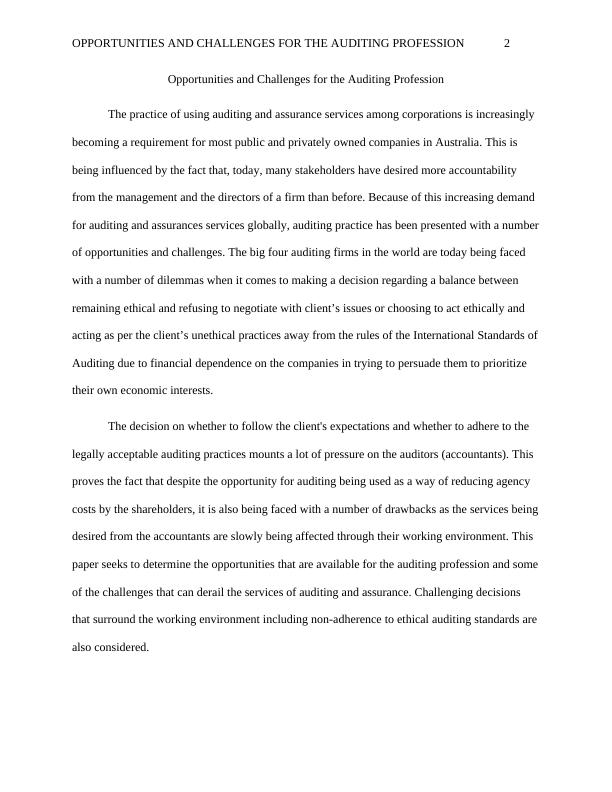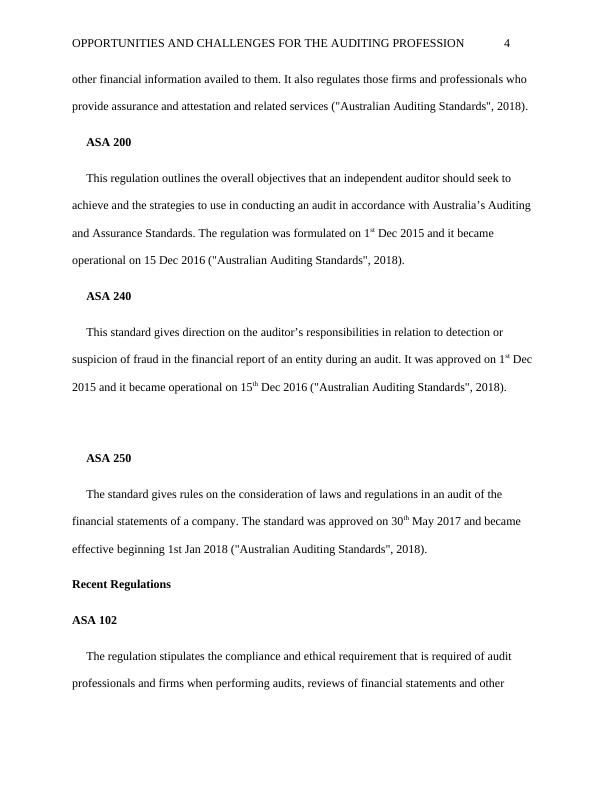Opportunities and Challenges for the Auditing Profession
Added on 2023-06-07
14 Pages3437 Words79 Views
Running head: THE AUDITING PROFESSION 1
Opportunities and Challenges for the Auditing Profession
Your Name
Institutional Affiliation
Opportunities and Challenges for the Auditing Profession
Your Name
Institutional Affiliation

OPPORTUNITIES AND CHALLENGES FOR THE AUDITING PROFESSION 2
Opportunities and Challenges for the Auditing Profession
The practice of using auditing and assurance services among corporations is increasingly
becoming a requirement for most public and privately owned companies in Australia. This is
being influenced by the fact that, today, many stakeholders have desired more accountability
from the management and the directors of a firm than before. Because of this increasing demand
for auditing and assurances services globally, auditing practice has been presented with a number
of opportunities and challenges. The big four auditing firms in the world are today being faced
with a number of dilemmas when it comes to making a decision regarding a balance between
remaining ethical and refusing to negotiate with client’s issues or choosing to act ethically and
acting as per the client’s unethical practices away from the rules of the International Standards of
Auditing due to financial dependence on the companies in trying to persuade them to prioritize
their own economic interests.
The decision on whether to follow the client's expectations and whether to adhere to the
legally acceptable auditing practices mounts a lot of pressure on the auditors (accountants). This
proves the fact that despite the opportunity for auditing being used as a way of reducing agency
costs by the shareholders, it is also being faced with a number of drawbacks as the services being
desired from the accountants are slowly being affected through their working environment. This
paper seeks to determine the opportunities that are available for the auditing profession and some
of the challenges that can derail the services of auditing and assurance. Challenging decisions
that surround the working environment including non-adherence to ethical auditing standards are
also considered.
Opportunities and Challenges for the Auditing Profession
The practice of using auditing and assurance services among corporations is increasingly
becoming a requirement for most public and privately owned companies in Australia. This is
being influenced by the fact that, today, many stakeholders have desired more accountability
from the management and the directors of a firm than before. Because of this increasing demand
for auditing and assurances services globally, auditing practice has been presented with a number
of opportunities and challenges. The big four auditing firms in the world are today being faced
with a number of dilemmas when it comes to making a decision regarding a balance between
remaining ethical and refusing to negotiate with client’s issues or choosing to act ethically and
acting as per the client’s unethical practices away from the rules of the International Standards of
Auditing due to financial dependence on the companies in trying to persuade them to prioritize
their own economic interests.
The decision on whether to follow the client's expectations and whether to adhere to the
legally acceptable auditing practices mounts a lot of pressure on the auditors (accountants). This
proves the fact that despite the opportunity for auditing being used as a way of reducing agency
costs by the shareholders, it is also being faced with a number of drawbacks as the services being
desired from the accountants are slowly being affected through their working environment. This
paper seeks to determine the opportunities that are available for the auditing profession and some
of the challenges that can derail the services of auditing and assurance. Challenging decisions
that surround the working environment including non-adherence to ethical auditing standards are
also considered.

OPPORTUNITIES AND CHALLENGES FOR THE AUDITING PROFESSION 3
The Australian Auditing Model
The Australian Auditing practice is being regulated by the Australian Auditing and Assurance
Standards Board. Most of the standards are outlined under Section 336 of the Corporations Act
2001. The standards specify the manner in which professional accountants should behave when
conducting an audit. It also establishes the requirements needed of professional auditors
including the procedure for application for practice as an auditor and other explanatory
information. Section 336 of the Australian Corporations Act 2001, further outlines the
responsibilities of an auditor when engaged in an audit assignment or when engaging to
undertake an audit of financial statements (Hecimovic & Martinov-Bennie, 2011). To a further
extent, the Australian Auditing Standards also stipulates the form and the content of the auditor’s
report. Auditing Standards are therefore a very important source of information when auditing
the set of financial statements and other historical accounting information for a reporting entity
in Australia ("Australian Auditing Standards", 2018). In addition to the standards and the
stipulates of the Corporations Act, the auditing profession in Australia is also being guided by
the International Standards on Auditing (ISA) and the US Generally Accepted Accounting
Standards (USGAAP). The Act gives specific regulations as discussed below.
Australian Auditing Standards under Section 336 of the Corporations Act 2001
Past Regulations
ASQC 1
Beginning 1st Jan 2010, the Australian Auditing and Standards Board (AASB), requires
auditing firms to ensure quality control. This regulation applies to firms and individuals who
perform audits and or assurance engagements services based on an entity’s financial reports and
The Australian Auditing Model
The Australian Auditing practice is being regulated by the Australian Auditing and Assurance
Standards Board. Most of the standards are outlined under Section 336 of the Corporations Act
2001. The standards specify the manner in which professional accountants should behave when
conducting an audit. It also establishes the requirements needed of professional auditors
including the procedure for application for practice as an auditor and other explanatory
information. Section 336 of the Australian Corporations Act 2001, further outlines the
responsibilities of an auditor when engaged in an audit assignment or when engaging to
undertake an audit of financial statements (Hecimovic & Martinov-Bennie, 2011). To a further
extent, the Australian Auditing Standards also stipulates the form and the content of the auditor’s
report. Auditing Standards are therefore a very important source of information when auditing
the set of financial statements and other historical accounting information for a reporting entity
in Australia ("Australian Auditing Standards", 2018). In addition to the standards and the
stipulates of the Corporations Act, the auditing profession in Australia is also being guided by
the International Standards on Auditing (ISA) and the US Generally Accepted Accounting
Standards (USGAAP). The Act gives specific regulations as discussed below.
Australian Auditing Standards under Section 336 of the Corporations Act 2001
Past Regulations
ASQC 1
Beginning 1st Jan 2010, the Australian Auditing and Standards Board (AASB), requires
auditing firms to ensure quality control. This regulation applies to firms and individuals who
perform audits and or assurance engagements services based on an entity’s financial reports and

OPPORTUNITIES AND CHALLENGES FOR THE AUDITING PROFESSION 4
other financial information availed to them. It also regulates those firms and professionals who
provide assurance and attestation and related services ("Australian Auditing Standards", 2018).
ASA 200
This regulation outlines the overall objectives that an independent auditor should seek to
achieve and the strategies to use in conducting an audit in accordance with Australia’s Auditing
and Assurance Standards. The regulation was formulated on 1st Dec 2015 and it became
operational on 15 Dec 2016 ("Australian Auditing Standards", 2018).
ASA 240
This standard gives direction on the auditor’s responsibilities in relation to detection or
suspicion of fraud in the financial report of an entity during an audit. It was approved on 1st Dec
2015 and it became operational on 15th Dec 2016 ("Australian Auditing Standards", 2018).
ASA 250
The standard gives rules on the consideration of laws and regulations in an audit of the
financial statements of a company. The standard was approved on 30th May 2017 and became
effective beginning 1st Jan 2018 ("Australian Auditing Standards", 2018).
Recent Regulations
ASA 102
The regulation stipulates the compliance and ethical requirement that is required of audit
professionals and firms when performing audits, reviews of financial statements and other
other financial information availed to them. It also regulates those firms and professionals who
provide assurance and attestation and related services ("Australian Auditing Standards", 2018).
ASA 200
This regulation outlines the overall objectives that an independent auditor should seek to
achieve and the strategies to use in conducting an audit in accordance with Australia’s Auditing
and Assurance Standards. The regulation was formulated on 1st Dec 2015 and it became
operational on 15 Dec 2016 ("Australian Auditing Standards", 2018).
ASA 240
This standard gives direction on the auditor’s responsibilities in relation to detection or
suspicion of fraud in the financial report of an entity during an audit. It was approved on 1st Dec
2015 and it became operational on 15th Dec 2016 ("Australian Auditing Standards", 2018).
ASA 250
The standard gives rules on the consideration of laws and regulations in an audit of the
financial statements of a company. The standard was approved on 30th May 2017 and became
effective beginning 1st Jan 2018 ("Australian Auditing Standards", 2018).
Recent Regulations
ASA 102
The regulation stipulates the compliance and ethical requirement that is required of audit
professionals and firms when performing audits, reviews of financial statements and other

End of preview
Want to access all the pages? Upload your documents or become a member.
Related Documents
Auditing, Assurance & Services Assignmentlg...
|13
|3207
|49
Opportunities and Challenges for Auditors under Australian Auditing Modellg...
|15
|4149
|82
(PDF) Auditing and assurance : Some emerging issueslg...
|12
|3616
|169
Auditing Standards and Materiality in Financial Statements of Double Ink Printers Limitedlg...
|11
|2960
|153
Audit, Assurance and Compliance for Wesfarmers Limitedlg...
|16
|3732
|107
Auditing and Assurancelg...
|5
|1220
|313
